Sahale Stars
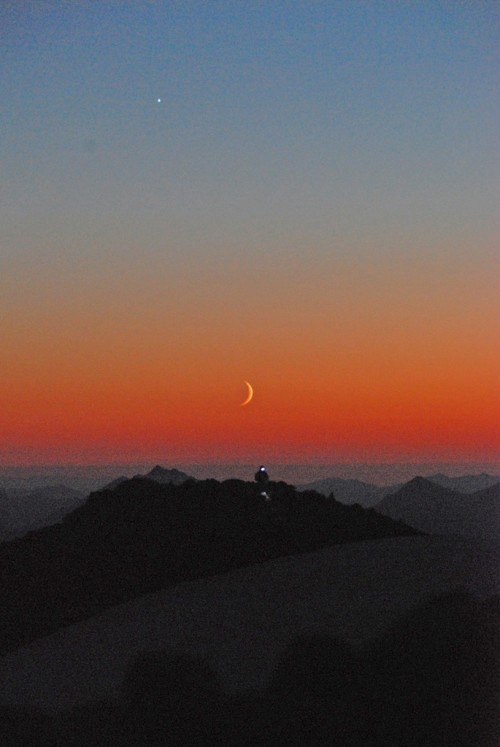
By Jack McLeod, guest blogger
I recently took the Spirit of Place writing workshop at the Learning Center with Nick O’Conell. Here’s my story from that workshop about a trip to Sahale Glacier. This is the third program I’ve participated in at the Institute and they’ve all been wonderful — so thank you!
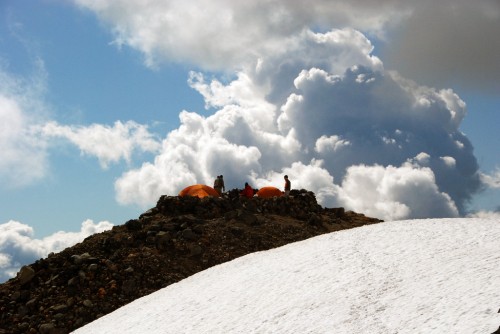
My tent shook violently. Straining its granite-bound guy lines, I was afraid it would release and pirouette like a wayward balloon to the valley 3,000′ below. An arc of stones only partly protected me from the midnight river of air as the tempest commanded our miniature snowbound island.
We had hiked to the realm of skydivers and found our rocky outpost was directly in the channel of atmospheric winds traveling from one side of Washington to the other. I’d waited 6 months for this date, a dark moonless night in the mountains and perfect venue for the annual Perseid Meteor Shower. But atmospheric forces make the ultimate decision around here and they threatened to blow us off the mountain. In the spirit of a long-ago boss’ mantra “we don’t have problems, we have challenges,” the question became could we turn nature’s uncontrollable forces into our hoped-for glorious experience?
The three of us intended to camp just below flower-covered Cascade Pass, an easy four-mile hike. Bob had minor backpacking experience, Brandon had none so we chose that site for its beauty and easy access. The ranger made sure we had the required bear canister to protect our food — and us. You don’t want anything smelling of food, including your skin, pack, tent or clothes. Ah, we thought, just why we went camping in the woods — to have meticulous hygiene. She also told us the forested, creek-side camp we planned to stay at for two nights was full. But there were still sites available at Sahale Glacier. What’s a couple more miles and a couple more thousand feet of climbing with a full pack? And no trees or tumbling stream. Camped next to ice. In August. We had come to get away from it all so the ranger’s only campsite choice became a perverse type of trip insurance. Little did we know how this change in locale would change everything about our experience.
The hike to the pass was uneventful — no slabs of ice came crashing down from cliff-hanging glaciers 2,000 feet above on Mt. Johannesburg — all the guidebooks mention this as a possibility. The route to our newly designated camp led across Sahale Arm, high above an ancient trade route between western and eastern Washington and on this day deep in blue and white candles of lupine and bistort. Indigenous travelers and traders crossed this pass between the lush, green forests of the Skagit River valley and the dry plains of the Columbia Plateau. A nearby archaeological site was dated to 9,600 years ago. Stone tool fragments were found but no signs of plastic bear canisters or 4 ounce isobutane stoves.
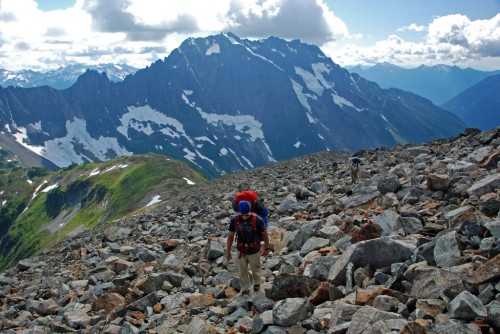
Climbing another 600 feet up the “trailâ€, weaving through disorganized boulder piles of two glacial moraines, we came to camp. A land of muted greys, browns and whites. An alpine world of rock, snow and cloud.
I looked out over our new realm – the one we hadn’t planned on. “This is why they call this The American Alps” I said. “This is like the Himalayas!” Brandon countered. Sharp, glacier-clad escarpments, ripsaw ridges and pinnacles of every variation on triangles stretched as far as we could see. The payoff of climbing to 7,200’ was obvious. And right behind us was the Sahale Glacier pouring 1,400’ down from Sahale Peak. No matter what else happened the next two days, we tasted glory.
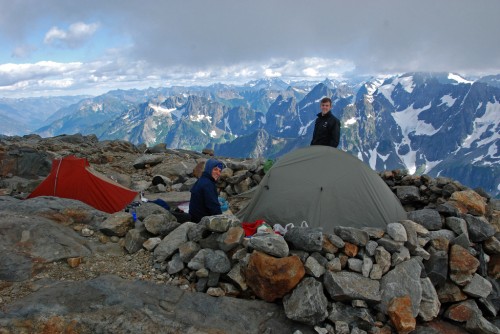
The “campsites†were rock islands surrounded by crusty snow, each circled by a low rock wall. For bear protection? To hide behind for snowball fights with other campers? They were bulkheads made (and remade) by climbers to protect tents from the river of wind. Gravity makes sure each newly arriving set of campers becomes a link in the lineage of rock wall builders so after choosing a shallow depression, barely large enough for our two light-weight tents, we lift large stones back to their defensive positions.
We set up camp, found a rivulet of glacial melt water, and ate hot curry which contrasted nicely with the color and coolness of our wintry surroundings. Sleep came soon. Invigorated by the cool, fresh air, I dozed off in the immense night time quiet.
Sunrise began as calm as sunset. Then I saw the river below. A grey flood as if a horizon-wide dam broke in the west draining fluid cloud. A vast sea of marine air was flowing, a steady directional flow filling the valleys, leaving archipelagos of peaks. A silent sea streaming with ripples, upwellings and waterfalls. The sun rose above a ridge behind me, tinting the sea yellowish and lavender. Was I really looking down on pastel cloud waterfalls filling in glacial basins? From our high camp I watched the noiseless spectacle, reveling in our fortune to end up here instead of down in the cloud-covered woods.
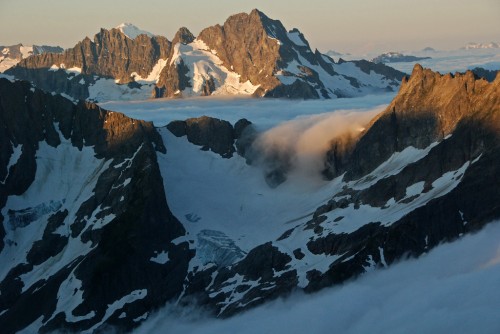
We explored. Our stone home was no ordinary speckled granite or sandstone. The Cascade Pass area is a juncture of faults and molten intrusions resulting in metaconglomerate, schist breccia, orthogneiss and other altered rocks. Superheated water carried dissolved minerals causing prospectors to look for gold, silver and lead 18 million years later. We explored the rock islands. Sensual curves of gneiss and granite were cross-cut with stripes of black, white and tan. We walked over textbook examples of the Law of Cross-Cutting Relationships, an old geology rule about sequencing the order of past events. Odd coloring caught our eye. Bands of ochre, rust and metallic blue led us to veins of pyrite and quartz crystals. Respectfully, we took pictures and left the crystals. We came for stars and meteors and found glitter in the rocks.
But the morning sea of clouds caught up with us. The grey flood of Pacific air flowed up-valley and enveloped everything. We worried about climbers on nearby Mt. Buckner. And about our ultimate trip goal – what I’d been anticipating for months was just hours away but threatened. There might be no stars, no Milky Way and no Perseids. We were surrounded. Card games in a crowded tent were followed by dinner with hot soothing potatoes. The air was calm but cold, dense, opaque. We felt marooned.
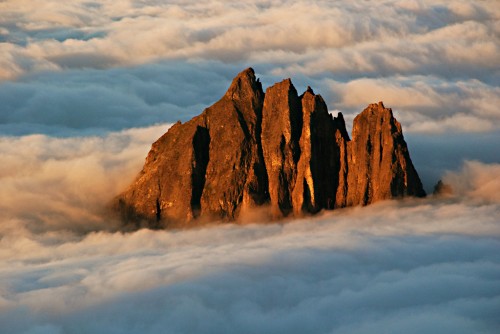
Grey turned to white, grey, white. Then windows of blue. Patches of sky played peak-a-boo for two hours until we were again looking down on the sea. We might have glory after all! For about the 10th time we thanked hikers below who beat us to lower camp forcing us to endure the pleasures of Sahale.
Sunset was quiet – no harbinger of what was to come in the early morning hours. A thin crescent moon slowly led Venus, Mars and Saturn into a darkening gradient of yellow, orange, pink and purple. The climbers trudged back successful, their tired bodies and ice axes silhouetted against the dimming sky. My watch alarm was set to after midnight. Finally, the moment to crawl out of my sleeping bag and revel in the star show was near. Drifting to sleep I heard a slight flutter of nylon.
My tent violently shakes. I’m instantly alert. It’s 12:30. Another roar, harder. Will my tent survive this? Will I? Should I stay inside? The world had erupted out side. The silent sea was now a raging gale overwhelming our little atoll. What to do?
“Jack, c’mon out, the stars are great!†I barely hear Bob say. What?! Is he in the same world? Are we in Heaven? Unzipping the frenetically rippling door I look out, feel the wind howl in my face and see… peace. The darkest sky and the Milky Way blazing from the southwest horizon to the northeast. Stars so numerous I’m giddy.
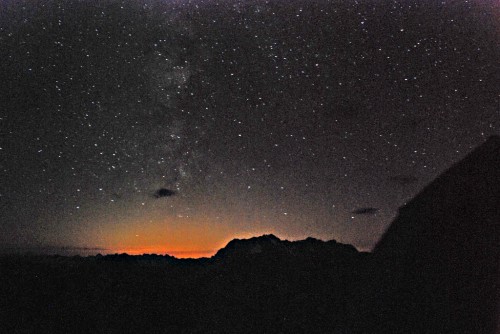
Cold wind slapped tassels in my face. But tranquility reigned above, and there… a silent shooting star blipped across. Where was Bob? Laying in the lowest spot snuggled in his sleeping bag enjoying the celestial theater. The crazed atmosphere wails. The tent rocks. I place two of our fortress rocks inside my thin nylon shelter to ensure it doesn’t elope with the air.
Then… I too lay in my sleeping bag as low as possible against the rock and draw the chord tight just exposing my face. The wind unrelentingly bellows but that’s ok. The silence is above and we see it. “Ooooh, that was a good one†we simultaneously say. Embracing the granite and the cold cacophony around us, we settle in for the show.
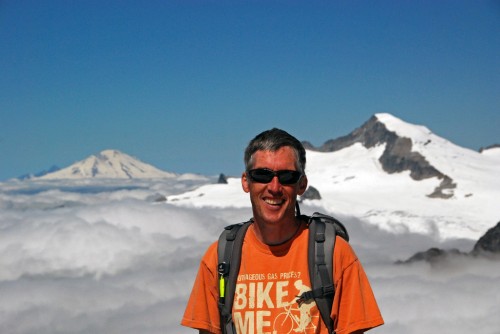
![]() Story and photos by jackmc. All rights reserved. More pictures of this trip are at http://www.flickr.com/photos/jackmc/sets/72157624601668963/with/4892756420.
Story and photos by jackmc. All rights reserved. More pictures of this trip are at http://www.flickr.com/photos/jackmc/sets/72157624601668963/with/4892756420.


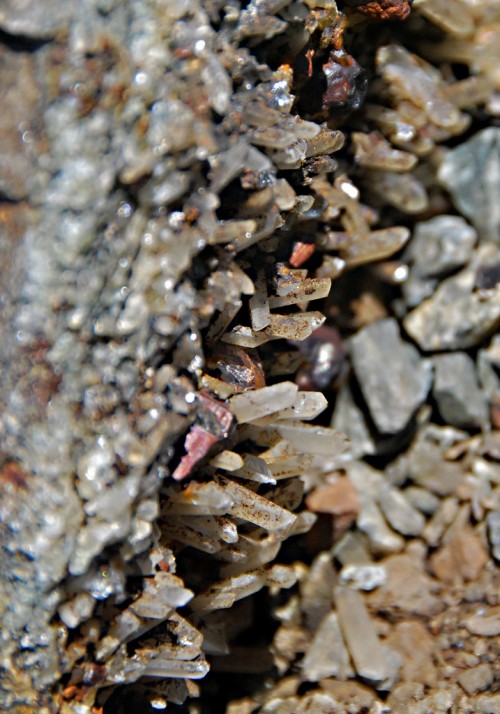
Jack,
Excellent story, stunning photos. Nice work getting it into shape!
Best,
Nick
Jack:
I’m in awe of your writing and the photos. Thanks for this-
Charlie
Jack, what a wonderful post! I had no idea that you were good friends with my friend Bob. I had seen your photos on Facebook, of all places, under Bob’s photo albums and just now made the connection that the Bob you were talking about in this story was the Bob I knew. What a wonderful story, fresh with natural and cultural history and personal passion. I’ve been on the Sahale arm, but not up to the glacier, and this post makes me want to race up there right now and do it! Perhaps the weather will hold in late October… but I doubt it. Next August, then!
Jack, you dog. I’m so jealous. You’re writing was so descriptive I didn’t need the pictures but I’m soooo glad you included them. Thailand has many beauties, but there’s no place like home, there’s no place like home, there’s no place like home. Looks like I need to find some ruby slippers.
Best Regards,
Gary
This was so beautiful. Thank you!
This was so well written. I really enjoyed reading it. Thank you for sharing!